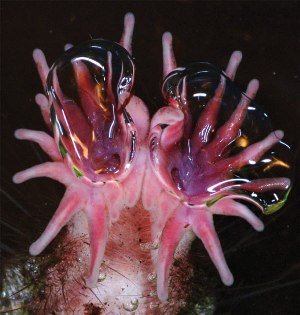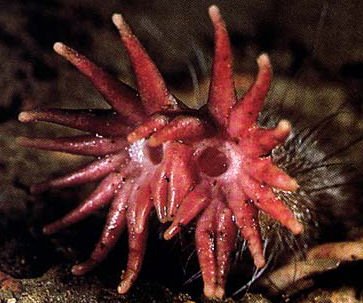
Hi everyone,
It's time for the new episode of Animalistiary, a Steemit-based online animal magazine designed to discuss interesting facts about animals which have been featured in the previous article entitled the Animal Series. In this episode, we will discuss regarding a sophisticated visual system possessed by a star-nosed mole. I know, it's a little bit different compared to the previous Animalistiary but sometimes, changes are good. I will try to explain things as simple as possible and I would like to stress that the main point of this article is not to understand completely regarding the function of a star-nosed mole visual system but rather, to appreciate the uniqueness of this animal being one of the creatures which have been considered hideous in the world (I think they were quite badass, though). A little introduction regarding the star-nosed mole:
- The star-nosed mole doesn't use its eyes for vision. Even if the eyes look functional, they act more like an accessory rather than a real eye which can usually be used for sight.
- The tentacles which surround the plate around its nose were able to detect even the tiniest vibrations of seismic wave.
- The tentacles were ultra sensitive and were used for tactile vision. If you have never seen a star-nosed mole before, they walk by touching every single thing in the environment with the ultra-sensitive tentacles and if by luck they touch a potential prey, well you can guess what's going to happen right?
- They have been regarded as one of the fastest eating animals in the world taking approximately 130 milliseconds to decide whether or not the objects in contact with its tentacles were edible or not.
To be honest, at first, I thought the tentacles around the star-nosed mole were non-functional but after going through a little bit of a research, the tentacles might be one of the most useful organs in its body. Without further ado, let's take a look at the visual system of this animal. I mean, if the physical eyes were non-functional, there must be some way for them to access the environment, ensuring the survivability of its species.
A Unique Visual System

For those who are not familiar with this kind of animal, the name star-nosed mole is quite literal. It's not an actual star or anything, but the compartment of its nose was arranged to look like a star, making it one of the most unique animals in the world. If you're going to look at its nose closely, you will realise that the appendages which extend outward appear more like tentacles than a star. There are 22 projections that spread quite randomly which make us wonder what kind of specialised function does this weird looking nose could perform.
The star-shaped nose was grouped into eleven pairs of tentacles with the 11th pair located at the centre along with a high-resolution visual area called the fovea. If you are familiar with the visual system in the human's eye, you will know that fovea is an area located at the macula which provides the clearest vision. The same goes with the star-shaped nose owned by this species of mole. Their nose will not only function as an organ which can detect smell but also act as an extra eye which is operated by the sense of touch.
It's quite sophisticated if you think about it; you can see by touching and like the human eyes, the first 10 pairs of appendages work as a peripheral vision. The 11th pair of tentacles is quite flexible and it acts like a central vision; if the peripheral vision detects favourable stimuli such as prey or a mating partner, the 11th pair of tentacles would be directed to the pair of peripheral tentacles which detect the stimuli to get a clearer view. The tentacles were operated by tendons with a few sets of muscle allowing it to navigate the environment, making the movement of the tentacles seem purely mechanical.
Each tentacle is equipped with a specialised structure called the Eimer's organ which makes it sensitive to a sense of touch. Eimer's organ is a bulbous-shaped papilla which formed on the epidermis of each tentacle containing a various number of afferent nerve fibres innervation. Even though the 11th pair of tentacles is the most sensitive area when it comes to vision, they are innervated by a less number of Eimer's organs compared to the peripheral tentacles. The only fact that can explain why is it so is because the number of nerve fibres running through Eimer's organ was higher at the centre. The first 9 tentacles' Eimer's organs were innervated by 4 nerve fibres each while the 10th and 11th Eimer's organs were innervated by 6 and 8 nerve fibres respectively.
The star-nosed mole is not the only species of mole which has Eimer's organs. All of the species of moles have it but the star-nosed mole possessed the highest number (25,000 units of Eimer's organs per star-nosed mole). Even though it appears that this creature possessed a pair of eyes, they are functionally blind. Their eyes can't detect a source of light and every single function related to vision were contributed by the tentacles which can be found on the nose of this amazing creature.
The Importance of The Star-Shaped Nose In Foraging

Although the size of its nose is less than 1 cm (approximately the size of our fingertip) and make up for less than 10% of its overall body size, the importance of this organ can be visualised by the percentage of brain's capacity they were using to process the signal sent by its nose. An experiment conducted in 2011 by Catania and Kenneth has found that almost 52% of its brain capacity was reserved to process surrounding images sent by the Eimer's organ which can be found on its nose.
The image produced by tentacles would be processed by the adjacent brain cortex (the signal produced by the left positioned tentacles would be sent to the right brain's cortex). It is worth noting that even though the 11th pairs of tentacles have less number of Eimer's organs, they possessed the highest number of afferent nerves innervation making the majority portion of the somatosensory cortex of the brain devoted for its impulses. If you are wondering how sensitive their nose can be, human hands were made up out of approximately 17,000 afferent neurons (per hand) while the nose of a star-nosed mole was made up out of 100,000 afferent neurons.
Pretty neat isn't it? They can determine the position of their prey in just 8 milliseconds before thrusting forward to catch them, thanks to its efficient nervous system. When they are in touch with a potential prey, the 11th pair of tentacles would quickly move to the site of contact, analysing and finally determines whether or not the object in contact is a favourable source of food. If they were in the water, the foraging behaviour became quite different. They will be using most of their olfactory senses rather than tactile senses to detect a potential prey.
Olfactory? Does it mean they can smell underwater? Yes, they are. The method is quite different and before they try to search for any potential prey by smell, they need to create bubbles (usually around 10-12 bubbles per second) with their nose (blow their nose underwater) which are usually directed at a potential area which they suspect might be harboured by prey. Within a second, they will breathe in the bubbles to detect any smell related to the position of their prey or trails left behind by them. Quite impressive won't you say? Before the discovery of this creature, there are no other known mammals which have the same ability as this creature.
One of the most controversial scientific theories regarding how the set of tentacles actually work was presented by Gould in the year of 1993. He and his team believe that there is some kind of electroreceptors which has been receiving some sort of electrical signal from a potential prey making it easier for them to identify the exact location of their own prey. The hypothesis was further tested by using two different kinds of worms (one of the natural prey for a star-nosed mole). On one side, they prepared an earthworm for the creature and on another, the potential prey was presented as an artificial worm which could produce a variable simulated electrical field. They found that the star-nosed mole preferred the artificial worm over the earthworm which kinda strengthens their hypothesis. However, their contribution was not being accepted by the scientific community as the explanation which stated that the tentacles can produce vision by mean of tactility is more relevant.
Click on the link below to read the original article:

References and further reading materials
- How the Star-Nosed Mole ‘Sees’ With Its Ultra-Sensitive Snout. Retrieved on May 30th, 2018.
- Inside the Bizarre Life of the Star-Nosed Mole, World's Fastest Eater. Retrieved on May 30th, 2018.
- Totally bizarre facts about the star-nosed mole. Retrieved on May 30th, 2018.
- The sense of touch in the star-nosed mole: from mechanoreceptors to the brain. Retrieved on May 30th, 2018.
- Star-nosed mole. Retrieved on May 30th, 2018.

SteemSTEM is a community project with the goal to promote and support Science, Technology, Engineering and Mathematics on the Steem blockchain. If you wish to support the steemSTEM project you can:
Discord community | Delegate SP to steemstemContribute STEM content using the #steemstem tag | Support steemstem authors | Join our curation trail | Visit our



Gees this is scary! Can't even bear looking at it. I think the concept of animanitiary is a very educative one meant to unveil those unique creatures so many of us may not have been aware of. Today, I know about star nosed mole, thanks to this scheme. But hey; what a weird way of using olfactory to locate preys... Everyone to its nature, what a behavioral characteristic!
Interesting read.
Regards,
@eurogee of @euronation and @steemstem communities
Yeah, this creature is weird in some way. Btw it's Animalistiary, not Animanitiary. :)
✌️
I can't think of another mammal that uses touch as its main sense. Or any other animal more advanced than a worm. It's quite unique
I cannot prevent myself from thinking about my piece of garden invaded by moles... Probably not a star-nosed one. Still trying to get rid of them but in a non-destructive manner. Just making them understand this is 'my' garden ;)
Except is, Interesting beast. Nature rarely makes things for nothing, including tentacles ;)
How "non-destructive" are we talking about here?
beer, noise, etc... Not touching or hurting them.
Hi @chloroform!
Your post was upvoted by utopian.io in cooperation with steemstem - supporting knowledge, innovation and technological advancement on the Steem Blockchain.
Contribute to Open Source with utopian.io
Learn how to contribute on our website and join the new open source economy.
Want to chat? Join the Utopian Community on Discord https://discord.gg/h52nFrV
Congratulations @chloroform! You have completed some achievement on Steemit and have been rewarded with new badge(s) :
Click on any badge to view your Board of Honor.
For more information about SteemitBoard, click here
If you no longer want to receive notifications, reply to this comment with the word
STOPDo not miss the last announcement from @steemitboard!